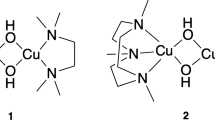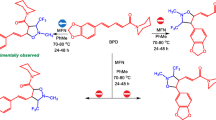Abstract
Correlations between DFT and experimental measurements on Zn2+ and Ni2+ chiral meso-(α,β-unsaturated)- porphyrins were performed using Kohn-Sham methodology. The exchange-correlation Becke88–Perdew86 functional was used in conjunction with double-zeta Slater basis sets. An accurate description of the electronic processes depending on the metal ion (Zn, Ni) or ligand (perilaldehyde and myrtenal) was made, confirming experimental results in terms of structural and electronic modifications. Moreover, this theoretical study provides a stronger knowledge and interpretation of the dynamical conformational features of the free base, Zn and Ni structures. Fundamental links between the central metallic atom and distortions of the porphyrinic core and ligands were demonstrated, in agreement with experimental data. We observed that the core in ZnPeriP and ZnMyrtP species is almost flat, in comparison with the Ni porphyrinic core, which appeared much more distorted. The type of distortion differs between PeriP and MyrtP ligands, with a combined saddled-ruffled characteristic with the former and a pronounced ruffled twisting for the latter. Finally, conformational energy barriers were extracted by spinning one of the arms in steps of 20° in a 360° dihedral angle. The resulted conformational barriers for NiPeriP or NiMyrtP are lower in energy than for ZnPeriP or ZnMyrtP, in agreement with experimental data.






Similar content being viewed by others
References
Zhu H, Li Q (2016) Novel molecular non-volatile memory: application of redox-active molecules. Appl Sci 6:7
Zhu H, Pookpanratana SJ, Bonevich JE, Natoli SN, Hacker CA, Ren T, Suehle JS, Richter CA, Li Q (2015) Redox-active molecular nanowire flash memory for high-endurance and high-density nonvolatile memory applications. ACS Appl Mater Interfaces 7(49):27306–27313
Hatzell KB, Boota M, Kumbur EC, Gogotsi Y (2015) Flowable conducting particle networks in redox-active electrolytes for grid energy storage. J Electrochem Soc 162(5):A5007–A5012
Woo LK, Goll JG (1989) Multielectron redox reactions between manganese porphyrins mediated by nitrogen atom transfer. J Am Chem Soc 111:3755–3757
Lokesh KS, De Keersmaecker M, Adriaens A (2012) Self-assembled films of porphyrins with amine groups at different positions: influence of their orientation on the corrosion inhibition and the electrocatalytic activity. Molecules 17:7824–7842
Amanpour J, Hu G, Alexy EJ, Mandal AK, Kang SH, Yuen JM, Diers JR, Lindsey SJ, Holten D, Bocian DF (2016) Tuning the electronic structure and properties of Perylene–porphyrin–Perylene panchromatic absorbers. J Phys Chem A 120:7434–7450
Roth KM, Dontha N, Dabke RB, Gryko DT, Clausen C, Lindsey JS, Bocian DF, Kuhr WG (2000) Molecular approach toward information storage based on the redox properties of porphyrins in self-assembled monolayers. J Vac Sci Technol B 18:2359–2364
Jiao J, Anariba F, Tiznado H, Schmidt I, Lindsey JS, Zaera F, Bocian DF (2006) Stepwise formation and characterization of covalently linked multiporphyrin-imide architectures on Si(100). J Am Chem Soc 128:6965–6974
Tsekouras G, Minder N, Figgemeier E, Johansson O, Lomoth R (2008) A bistable electrochromic material based on a hysteretic molecular switch immobilised on nanoparticulate metal oxide. J Mater Chem 18:5824–5829
Duan X, Huang Y, Lieber CM (2002) Nano Lett 2(5):487–490
Simão C, Mas-Torrent M, Crivillers N, Lloveras V, Artés JM, Gorostiza P, Veciana J, Rovira C (2011) A robust molecular platform for non-volatile memory devices with optical and magnetic responses. Nat Chem 5:359–364
Zhitenev NB, Sidorenko A, Tennant DM, Cirelli RA (2007) Chemical modification of the electronic conducting states in polymer nanodevices. Nat Nanotechnol 2:237–242
Fateeva A, Pécaut J, Bayle P-A, Maldivi P, Dubois L (2009) Synthesis of chiral bridled porphyrins in their two enantiomeric forms. Eur J Org Chem 23:3845–3848
Maheut G, Castaings A, Pécaut J, Daku LML, Pescitelli G, Di Bari L, Marchon J-C (2006) Chiroptical and computational studies of a bridled chiroporphyrin and of its nickel(II), copper(II), and zinc(II) complexes. J Am Chem Soc 128(19):6347–6356
Duclairoir F, Dubois L, Calborean A, Fateeva A, Fleury B (2010) Bistable molecules development and Si surface grafting: two chemical tools used for the fabrication of hybrid molecule/Si CMOS component. Int J Nanotechnol 7:719–737
Fateeva A, Calborean A, Pécaut J, Maldivi P, Marchon J-C, Dubois L (2008) Synthesis and conformational studies of chiral meso-(α, β-unsaturated)-porphyrins. Tetrahedron 64:10874–10881
Pang T (2006) An introduction to computational physics, 2nd edn. Cambridge University Press, Cambridge
Koch W, Holthausen MC (2001) A Chemist’s guide to density functional theory, 2nd edn. Wiley-VCH, Weinheim
Buimaga-Iarinca L, Morari C (2014) Adsorption of small aromatic molecules on gold: a DFT localized basis set study including van der Waals effects. Theor Chem Accounts 133(7):1502
Vangberg T, Ghosh A (1999) A first-principles quantum chemical analysis of the factors controlling ruffling deformations of porphyrins: insights from the molecular structures and potential energy surfaces of silicon, phosphorus, germanium, and arsenic porphyrins and of a peroxidase compound I model. J Am Chem Soc 121(51):12154–12160
Scheidt RW, Kastner ME, Hatano K (1978) Stereochemistry of the toluene solvate of .alpha.,.beta.,.gamma.,.delta.-tetraphenylporphinatozinc(II). Inorg Chem 17:706–710
Maclean AL, Foran GJ, Kennedy BJ, Turner P, Hambley TW (1996) Structural characterization of nickel(II) tetraphenylporphyrin. Aust J Chem 49(12):1273–1278
Veyrat M, Maury O, Faverjon F, Over DE, Ramasseul R, Marchon JC, Turowska-Tyrk I, Scheidt WR (1994) Chiroporphyrins: an approach to asymmetric catalysts with stereocenters near the plane of the porphyrin ring. Angew Chem Int Ed Engl 33:220–223
Acknowledgment
Financial support from the National Authority for Scientific Research and Innovation (ANCSI), Core Programme, Project PN16-30 02 01 is gratefully acknowledged.
Author information
Authors and Affiliations
Corresponding author
Rights and permissions
About this article
Cite this article
Calborean, A., Graur, F. & Bintintan, V. DFT computational correlations on conformational barriers of Zn2+ and Ni2+ chiral meso-(α,β-unsaturated)- porphyrins. J Mol Model 23, 181 (2017). https://doi.org/10.1007/s00894-017-3350-8
Received:
Accepted:
Published:
DOI: https://doi.org/10.1007/s00894-017-3350-8




